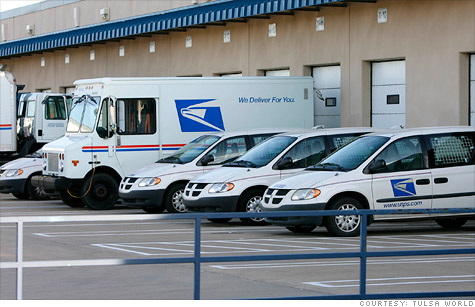
After 11 consecutive quarters of deficits, the US Postal Service finally saw some progress in the final quarter of 2012, as its reported quarterly deficit decreased from the previous quarter to "only" $1.3 Billion dollars. While relatively good news, this is still an indicator of an organization that continues to exist in dire financial and operational straights, as evidenced by its recent decision to cut Saturday delivery service in order to reduce operating costs. However, while the USPS has been decimated by private sector competition, including FedEx, UPS and the internet and email revolution, it may ultimately find salvation and rebirth thanks to one of the behemoths of the very private-sector internet businesses that have contributed to its downfall.
 Amazon.com, in a bid to expand beyond the internet and directly compete with big-box retailers, has been exploring the expansion of its delivery options to include same-day services. In order to offer such a service, the retailer will need to partner its supply chain with a delivery network that has a blanketed presence across the United States. That network already exists, and it is the United States Postal Service.
Amazon.com, in a bid to expand beyond the internet and directly compete with big-box retailers, has been exploring the expansion of its delivery options to include same-day services. In order to offer such a service, the retailer will need to partner its supply chain with a delivery network that has a blanketed presence across the United States. That network already exists, and it is the United States Postal Service. Amazon has long understood that unlike a competitor such as Walmart, it is better off focusing on its own supply network then getting into the tricky field of transportation logistics. This is similar to the decision made by the CDC, when it was creating its Vaccine Management Business Improvement Project. As discussed by Michal Copland in his Strategy+Business article "Smarter Medicine", the CDC focused on its own medical logistics network, and farmed out its supply and transportation to the private sector specialist McKesson.
Leveraging the already established network of the USPS also has many other benefits that can't necessarily be offered by other private-sector delivery carriers. First, as discussed in Capgemini's "2016 Future Supply Chain" report, there will be a need for retailer of the future to establish "collaborative warehouse and distribution" centers in order to decentralize the supply chain and bring it closer to the consumer. Although Amazon maintains regional warehouses to decrease deliver times, it can become even more efficient by leveraging the vast warehouse and transfer network of the USPS to further decentralize. Efficiencies and lead-time decreases can be achieved by having third-party suppliers ship directly to USPS regional locations, and by making possible cost and time saving techniques such as dry-docking and collaborative transportation and storage.
 Capgemini's report also focuses on how future supply chains can both decrease their transportation costs, as well as Co2 environmental impact. The USPS is perfectly equipped for this, as it's transportation network allows it to decrease waste by decentralizing from a standard large regional network down to a much more efficient neighborhood model. Instead of only relying on large trucks, the USPS adapts very well to both urban and non-urban areas through the efficient use of smaller delivery trucks and on-foot letter carriers when necessary.
Capgemini's report also focuses on how future supply chains can both decrease their transportation costs, as well as Co2 environmental impact. The USPS is perfectly equipped for this, as it's transportation network allows it to decrease waste by decentralizing from a standard large regional network down to a much more efficient neighborhood model. Instead of only relying on large trucks, the USPS adapts very well to both urban and non-urban areas through the efficient use of smaller delivery trucks and on-foot letter carriers when necessary. Lastly, the Capgemini report predicts a future where there is a "convergence between home shopping and neighborhood distribution via pick-up points". Amazon's box-retailer competition such as Walmart and Bestbuy are already moving towards this model with internet/retailer hybrid models that allow "same-day" pick-up at retail locations for items ordered online. Through the use of the vast USPS Post-Office network and by a greater integration with USPS region or city-specific warehousing, Amazon may be able to achieve a similar capability allowing for either same-day delivery or same-day Post Office pick-up. In the end, it looks like Amazon and USPS may end up being the perfect complementary pieces to create the supply chain of the future.
Resources
http://www.wired.com/business/2013/02/amazon-saves-postal-service/
http://247wallst.com/2013/02/08/usps-deficit-shrinks/

No comments:
Post a Comment
Note: Only a member of this blog may post a comment.